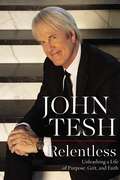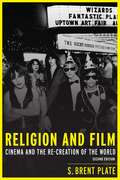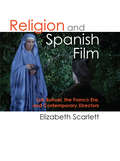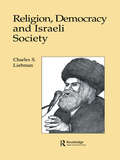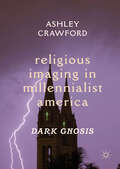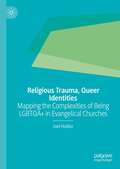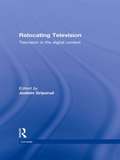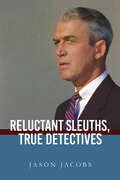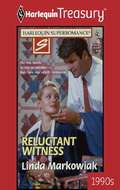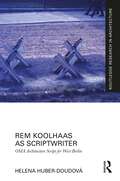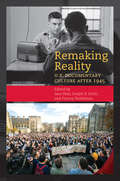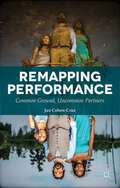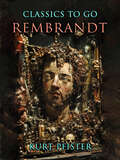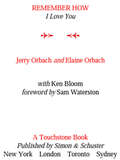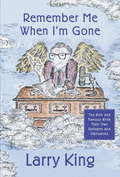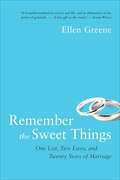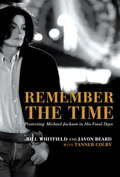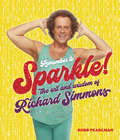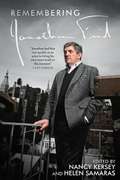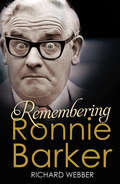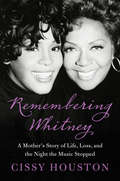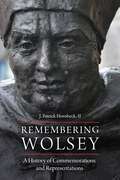- Table View
- List View
Relentless: Unleashing a Life of Purpose, Grit, and Faith
by John TeshJohn Tesh has achieved more in life than he ever dreamed possible. But the road to success has been anything but easy—and those challenges have become the secret to his success. Through his story, we can learn how to be relentless, how to achieve what we didn&’t think was possible, and how to handle our inevitable discouragements.In this engrossing memoir, Tesh describes how the obstacles that shaped him—including being suspended from college, living homeless for months, and facing a deadly disease—shaped his remarkable life. You&’ll hear, in never-before-told stories, how Tesh became the youngest correspondent at WCBS News less than thirty-six months after he was working at a gas station and sleeping in a public park. You&’ll go inside the unconventional way he composed the now-iconic theme song for NBC Sports basketball and how he and his wife, Connie Sellecca, created the popular, nationally-syndicated Intelligence for Your Life radio program. From live commentary for two Olympic Games to his decade-long role as co-host of Entertainment Tonight and the outrageous gamble that resulted in one of the most successful Public Television concert specials in history, you&’ll learn how Tesh applied his unique process of focused practice, grit, and perseverance while maintaining a single-minded pursuit of his goals. In 2015, he fought and received treatment for a stage-three cancer diagnosis, but when the cancer returned, he and his wife turned to relentless faith and divine healing scriptures to manifest a victory over the disease. Relentless is an astonishing story of how obstacles create opportunity and how faith will lead to triumph.
Relevance and Marginalisation in Scandinavian and European Performing Arts 1770–1860: Questioning Canons
by Randi Margrete SelvikRelevance and Marginalisation in Scandinavian and European Performing Arts 1770–1860: Questioning Canons reveals how various cultural processes have influenced what has been included, and what has been marginalised from canons of European music, dance, and theatre around the turn of the nineteenth century and the following decades. This collection of essays includes discussion of the piano repertory for young ladies in England; canonisation of the French minuet; marginalisation of the popular German dramatist Kotzebue from the dramatic canon; dance repertory and social life in Christiania (Oslo); informal cultural activities in Trondheim; repertory of Norwegian musical clocks; female itinerant performers in the Nordic sphere; preconditions, dissemination, and popularity of equestrian drama; marginalisation and amateur staging of a Singspiel by the renowned Danish playwright Oehlenschläger, also with perspectives on the music and its composers; and the perceived relevance of Henrik Ibsen’s staged theatre repertory and early dramas. By questioning established notions about canon, marginalisation, and relevance within the performing arts in the period 1770–1860, this book asserts itself as an intriguing text both to the culturally interested public and to scholars and students of musicology, dance research, and theatre studies.
Religion and Film: Cinema and the Re-creation of the World (Critical Concepts In Media And Cultural Studies)
by S. Brent PlateReligion and cinema share a capacity for world making, ritualizing, mythologizing, and creating sacred time and space. Through cinematography, mise-en-scène, editing, and other production activities, film takes the world “out there” and refashions it. Religion achieves similar ends by setting apart particular objects and periods of time, telling stories, and gathering people together for communal actions and concentrated focus. The result of both cinema and religious practice is a re-created world: a world of fantasy, a world of ideology, a world we long to live in, or a world we wish to avoid at all costs.Religion and Film introduces readers to both religious studies and film studies by focusing on the formal similarities between cinema and religious practices and on the ways they each re-create the world. Explorations of film show how the cinematic experience relies on similar aesthetic devices on which religious rituals have long relied: sight, sound, the taste of food, the body, and communal experience. Meanwhile, a deeper understanding of the aesthetic nature of religious rituals can alter our understanding of film production. Utilizing terminology and theoretical insights from the study of religion as well as the study of film, Religion and Film shows that by paying attention to the ways films are constructed, we can shed new light on the ways religious myths and rituals are constructed and vice versa.This thoroughly revised and expanded new edition is designed to appeal to the needs of courses in religion as well as film departments. In addition to two new chapters, this edition has been restructured into three distinct sections that offer students and instructors theories and methods for thinking about cinema in ways that more fully connect film studies with religious studies.
Religion and Spanish Film: Luis Buñuel, the Franco Era, and Contemporary Directors
by Elizabeth ScarlettTreatments of religion found in Spanish cinema range from the pious to the anticlerical and atheistic, and every position in between. In a nation with a strong Catholic tradition, resistance to and rebellion against religious norms go back almost as far as the notion of "Sacred Spain." Religion and Spanish Film provides a sustained study of the religious film genre in Spain practiced by mainstream Francoist film makers, the evolving iconoclasm, parody, and reinvention of the Catholic by internationally renowned Surrealist Luis Buñuel, and the ongoing battle of the secular versus the religious manifested in critically and popularly acclaimed directors Pedro Almodóvar, Julio Medem, Alejandro Amenábar, and many others. The conflicted Catholicism that emerges from examining religious themes in Spanish film history shows no sign of ending, as unresolved issues from the Civil War and Franco dictatorship, as well as the unsettled relationship between Church and State, continue into the present.
Religion, Democracy and Israeli Society
by Charles S. LiebmanFirst Published in 1997. The essays in this volume are revisions, in some cases substantial, to the 1995 Sherman Lectures which the author delivered at SOAS, the School of Oriental and African Studies of the University of London.
Religious Imaging in Millennialist America: Dark Gnosis
by Ashley CrawfordAshley Crawford investigates how such figures as Ben Marcus, Matthew Barney, and David Lynch—among other artists, novelists, and film directors—utilize religious themes and images via Christianity, Judaism, and Mormonism to form essentially mutated variations of mainstream belief systems. He seeks to determine what drives contemporary artists to deliver implicitly religious imagery within a ‘secular’ context. Particularly, how religious heritage and language, and the mutations within those, have impacted American culture to partake in an aesthetic of apocalyptism that underwrites it.
Religious Trauma, Queer Identities: Mapping the Complexities of Being LGBTQA+ in Evangelical Churches
by Joel HollierIn a polarised milieu that too often posits “queer” and “Christian” as competing realms, this book explores the complexities of identity development, religious traumatisation, and the task of creating safe faith spaces in which LGBTQA+ people can find healing, particularly in the Evangelical context. First, Joel Hollier examines the historical path of Evangelicalism, providing context for the current terrain of the “culture war” we find ourselves in. He then parses out experiences of gender/sexuality and religious/spiritual identity development, grounding them in an evolving theoretical base. Finally, Hollier offers a rounded critique of Evangelical church structures and mechanisms of trauma that hinder the healing process, along with potential sources of healing. Central to this work are the voices of LGBTQA+ people whose stories weave together a deeper understanding of the harms the Church has perpetrated, and the path forward.
Relocating Television: Television in the Digital Context (Comedia)
by Gripsrud JosteinFor over half a century, television has been the most central medium in Western democracies – the political, social and cultural centrepiece of the public sphere. Television has therefore rarely been studied in isolation from its socio-cultural and political context; there is always something important at stake when the forms and functions of television are on the agenda. The digitisation of television concerns the production, contents, distribution and reception of the medium, but also its position in the overall, largely digitised media system and public sphere where the internet plays a decisive role. The articles in this comprehensive collection are written by some of the world’s most prominent scholars in the field of media, communication and cultural studies, including critical film and television studies. Relocating Television offers readers an insight into studying television alongside the internet, participatory media and other technocultural phenomena such as DVDs, user-generated content and everyday digital media production. It also focuses on more specific programmes and phenomena, including The Wire, MSN, amateur footage in TV news, Bollywoodization of TV news, YouTube, fan sites tied to e.g. Grey's Anatomy and X Factor. Relocating Television will be highly beneficial to both students and academics across a wide range of undergraduate and postgraduate courses including media, communication and cultural studies, and television and film studies.
Reluctant Sleuths, True Detectives (SUNY series, Horizons of Cinema)
by Jason JacobsReluctant Sleuths, True Detectives examines the detective figure in four noir and neo-noir films: Out of the Past (1947), Notorious (1946), Vertigo (1958), and Chinatown (1974). Exploring the way that these characters each move from an initial state of reluctant passivity to one of passionate engagement with the world around them, it questions the cinematic forces required to motivate and move them. In its close examinations of each film, the book meditates on the detectives' hunts and how they interact with the cinematic apparatus that captures and presents them to an audience, and it tracks the receptive experience of these films in relation to these questions of motivation and movement.
Reluctant Witness: Robert Taylor, Hollywood, and Communism
by Linda MarkowiakReluctant Witness: Robert Taylor, Hollywood, Communism is the exhaustive biography of the life of Golden Era movie star, Robert Taylor. He was called "The Man With The Perfect Profile," and some considered him the most beautiful man to ever grace the movie world. Yet there was more to him, lots more. He was complicated. He saw history--movie history and world history--and he was part of both.
Rem Koolhaas as Scriptwriter: OMA Architecture Script for West Berlin (Routledge Research in Architecture)
by Helena Huber-DoudováThis book is the first survey of a new field in architecture theory: script writing. Rem Koolhaas as Scriptwriter explores the intersection of architecture, film, and text using the example of the working method of scriptwriter, Rem Koolhaas, and the Office for Metropolitan Architecture (OMA). This book argues that Koolhaas formulates his approach to architecture on the basis of the “written sketch” or script, and questions its transformations into built environment in the oeuvre of OMA. Divided into two parts, the first part is a theoretical outline that explores the notion of scriptwriting in film. It provides in-depth insights into the definition and historical evolution of the script—as a blueprint, Hollywood script, avant-garde script, storyboard, the relation to auteur theory, and the difference between the script and scenario. It surveys the first original script for the Exodus, of the Voluntary Prisoners of Architecture. The second part offers a unique perspective on the urban development of West Berlin, in which Koolhaas created a metropolitan script, or blueprint, that spans the period 1971–1989, from his first visit to Berlin to the fall of the Berlin Wall. This book will be of interest to researchers and students of architectural theory, urban history, and film studies.
Remaking Reality: U.S. Documentary Culture after 1945
by Sara Blair, Joseph B. Entin, and Franny NudelmanAfter World War II, U.S. documentarians engaged in a rigorous rethinking of established documentary practices and histories. Responding to the tumultuous transformations of the postwar era--the atomic age, the civil rights movement, the Vietnam War, the emergence of the environmental movement, immigration and refugee crises, student activism, the globalization of labor, and the financial collapse of 2008--documentary makers increasingly reconceived reality as the site of social conflict and saw their work as instrumental to struggles for justice. Examining a wide range of forms and media, including sound recording, narrative journalism, drawing, photography, film, and video, this book is a daring interdisciplinary study of documentary culture and practice from 1945 to the present. Essays by leading scholars across disciplines collectively explore the activist impulse of documentarians who not only record reality but also challenge their audiences to take part in reality's remaking.In addition to the editors, the volume's contributors include Michael Mark Cohen, Grace Elizabeth Hale, Matthew Frye Jacobson, Jonathan Kahana, Leigh Raiford, Rebecca M. Schreiber, Noah Tsika, Laura Wexler, and Daniel Worden.
Remapping Performance: Common Ground, Uncommon Partners
by Jan Cohen-CruzCompleting a trilogy of works by Jan Cohen-Cruz, Remapping Performance focuses on the work of artists and experts who collaborate across fields to address social issues. The book explores work of a range of artists who employ artistic training, methodologies and mind-sets in their work with experts from other sectors such as medicine and healthcare and from other disciplines, to draw an expanded map of performance platforms including university/ community partnerships, neighbourhood-bases, and cultural diplomacy. Case studies include ArtSpot Productions/Mondo Bizarro's Cry You One about climate change in southern Louisiana, incorporating theatrics and organizing; Michael Rohd/Sojourn Theatre's social and civic practices; Anne Basting's University of Wisconsin-Milwaukee-based integration of performance and creative aging; and the collaborative cultural diplomacy experiment, smARTpower. Short companion pieces add expertise from Helen Nicholson, Todd London, Julie Thompson Klein, Nancy Cantor, Maria Rosario Jackson, and Penny Von Eschen. Jan Cohen-Cruz ends with suggestions for fully integrating performance in cross-sector initiatives. This latest book by a leading figure in engaged/ applied theatre and performance builds on its predecessors by offering a future-oriented perspective, a vision of art and performance interacting with a range of social sectors and with an emphasis on HE in such partnerships, and will be a 'must-read' for all students and scholars working in this field.
Rembrandt: Neubearbeitung Der Ungekürzten Originalfassung (Classics To Go)
by Kurt Pfister"Rembrandt" von Kurt Pfister bietet einen tiefgehenden Einblick in die komplexe Welt eines der rätselhaftesten und einflussreichsten Künstler des 17. Jahrhunderts – Rembrandt van Rijn. Das Buch beleuchtet nicht nur Rembrandts künstlerische Meisterwerke, sondern widmet sich auch seinem persönlichen Leben und fängt das feine Zusammenspiel zwischen seinem schöpferischen Genie und seinen menschlichen Schwächen ein. Pfister zeichnet ein Porträt Rembrandts, das seinen Kampf und seine Erfolge hervorhebt, seinen Weg durch ein bewegtes soziales und wirtschaftliches Umfeld nachzeichnet und seinen bleibenden Einfluss auf die Kunstwelt würdigt. Durch Pfisters Perspektive erscheint Rembrandt als eine Figur, die sich über die Konventionen seiner Zeit hinwegsetzte – Licht und Schatten dienten ihm nicht nur als künstlerische Mittel, sondern auch als Metaphern für die menschliche Erfahrung an sich. Die Themen Widerstandskraft, das Streben nach Authentizität und die Auseinandersetzung mit der menschlichen Existenz sprechen stark Menschen von heute an – in einer Welt, in der Echtheit zunehmend mehr geschätzt wird als bloßer Schein und persönliche Kämpfe oft vor dem Hintergrund gesellschaftlichen Wandels stattfinden. Rembrandts Geschichte erinnert im heutigen Leben an die zeitlose Kraft von Kunst und Ausdruck. Das Buch bietet nicht nur Kunstliebhabern und Historikern wertvolle Einblicke, sondern auch allen, die sich für die universelle Suche nach Sinn und Selbstausdruck interessieren. Es lädt Leserinnen und Leser ein, die in Kunst, Geschichte und menschlichen Geschichten Inspiration finden, eine Persönlichkeit zu entdecken, deren Leben so vielschichtig war wie seine gefeierten Werke.
Remember How I Love You
by Jerry Orbach Elaine Orbach Sam Waterston Ken BloomEvery morning for the thirteen years he was on Law & Order, Jerry Orbach wrote his wife a short love poem and placed it next to her coffee cup before he left for work. Over the years Jerry wrote hundreds of notes -- all of which Elaine cherished and preserved. Now dozens of Jerry's most meaningful poems to Elaine, along with stories from his amazing career and their enduring romance, tell the tale of their life together. With essays from some of Jerry's dearest friends and a foreword by Sam Waterston, Elaine created a collection of funny and moving poetry and a tribute to a wonderful marriage and a dearly loved man. The world remembers Jerry as a legendary Broadway actor, Baby's father in Dirty Dancing, and of course the wisecracking detective Lenny Briscoe on Law & Order. But to his widow, Elaine, Jerry was a poet...and the love of her life.
Remember Me When I'm Gone: The Rich and Famous Write Their Own Epitaphs and Obituaries
by Larry King“Show me Heaven! I have seen hell.” —Patricia NealLarry King, world-famous radio and television personality, has asked the talented, the beautiful, the wise, and the rich a question all of us have pondered: How would you like to be remembered after your death? The result is REMEMBER ME WHEN I'M GONE, an entertaining and eloquent collection of “last words” from people in the arts, in politics, in sports, and in business, mostly still alive. In telling and moving reflections, often leavened by self-deprecating humor, these celebrities look back on their lives, their ambitions, their mistakes, and their accomplishments.The contributions range from pithy one-liners by Yogi Berra (“It’s over.”), Dave Barry, George Carlin, and Liz Smith (“Excuse my dust!”); to inspired sketches by Stephen King and Peter Falk; to candid reflections from Don Shula, Fred Rogers, and Chevy Chase; to hilarious rants from Margaret Cho and Tommy Lee; and a last request by Arthur Hailey. Often surprising and always memorable, REMEMBER ME WHEN I'M GONE is a timeless collection by stars who will live on forever.
Remember the Sweet Things: One List, Two Lives, and Twenty Years of Marriage
by Ellen GreeneFor twenty years, Ellen Greene kept a running list of the thoughtful, funny, touching things that her husband, Marsh, said and did. She wrote them down secretly, then shared them with him every Valentine’s Day when he would find pages from her “Sweet Things List” tucked inside a card. A lovely and poignant tribute to a man and a marriage, written with grace and candor, Remember the Sweet Things captures the kindness, sharing, humor, and affection that defined the Greenes’ union and encourages us to acknowledge the goodness in our own lives and relationships.
Remember the Time
by Tanner Colby Bill Whitfield Javon BeardMichael Jackson's former bodyguards reveal the amazing truths of the superstar's final 2 years--his life in hiding with his children, the financial crises that forced him into the ill-fated This Is It tour, and the events that led to his shocking death. On the brink of financial ruin and driven from his beloved sanctuary at Neverland , Michael Jackson spent his final years living like a nomad, moving his 3 children from the Middle East to Ireland to Las Vegas to Virginia and finally back to Los Angeles, living in near-total seclusion in a futile attempt to escape a world that wouldn't leave him alone. Starting with Jackson's secret return to the U.S. in 2006, Bill Whitfield and Javon Beard--a veteran security professional and a brash, untested rookie, both single fathers themselves--served as the singer's personal security team. Stationed at his side nearly 24/7, they were the gatekeepers between Michael and the outside world, making them the only 2 men who know what 60 million fans around the world are still desperate to find out: What really happened to the King of Pop?; How Michael and his children stayed under the radar from day to day; the efforts required to give the 3 kids some semblance of a normal life; the simple joys they found to fill their days; the true extent of Michael's financial crises (Whitfield and Beard were often not paid for months); the open warfare with the Jackson family; and the star's increasing paranoia--the truth is far more compelling than anything previously reported. An indispensable piece of pop-culture history, Remember the Time is the heartfelt story of a tragic and troubled family, the devastating cost of fame, and the lengths to which a father will go to protect and provide for his children. Remember the Time dismantles the tabloid myths once and for all and gives Michael Jackson back his humanity.From the Hardcover edition.
Remember the Time: Protecting Michael Jackson In His Final Days
by Tanner Colby Bill Whitfield Javon BeardMichael JacksonOCOs former bodyguards discuss the superstarOCOs life in seclusion, financial crises, and the lead up to his shocking death. "
Remember to Sparkle!: The Wit & Wisdom of Richard Simmons
by Richard Simmons Robb PearlmanRichard Simmons -- once the World's Favorite Fitness Guru and today a much sought-after cult figure primed for relaunch -- takes the spotlight in this officially licensed inspirational gift book featuring a delightful collection of his inimitable words of wisdom and colorful photos.Known for his signature hairstyle and short shorts, coupled with an infectious exuberance and comforting approach, Richard Simmons has inspired millions over the past forty years to meet their fitness goals and feel great. Remember to Sparkle: The Wit & Wisdom of Richard Simmons is a collection of the motivational superstar's life lessons not just on fitness but on overall wellness, self-esteem, and hope. Accompanied by a spirited and colorful collection of photos, this book captures Simmons' voice and personality and will lift the spirits with every turn of the page.
Remembering Jonathan Frid
by Nancy Kersey Helen Samaras[from the back cover:] Jonathan Frid was thought to be something of a mysterious figure: He disliked the celebrity spotlight, he never aspired to stardom and seldom spoke about his private life. What made him tick? What kind of a man was he? From his early days on the stage to his time as vampire Barnabas Collins on the cult television classic Dark Shadows, Remembering Jonathan Frid gathers friends, family and colleagues to share their insights and memories of this complex and talented actor, illustrated throughout with over 130 rare and unseen photographs."
Remembering Mass Violence
by Steven High Thi Ry Duong Edward LittleRemembering Mass Violence breaks new ground in oral history, new media, and performance studies by exploring what is at stake when we attempt to represent war, genocide, and other violations of human rights in a variety of creative works. A model of community-university collaboration, it includes contributions from scholars in a wide range of disciplines, survivors of mass violence, and performers and artists who have created works based on these events.This anthology is global in focus, with essays on Africa, Asia, Europe, Latin America, and North America. At its core is a productive tension between public and private memory, a dialogue between autobiography and biography, and between individual experience and societal transformation. Remembering Mass Violence will appeal to oral historians, digital practitioners and performance-based artists around the world, as well researchers and activists involved in human rights research, migration studies, and genocide studies.
Remembering Ronnie Barker
by Richard WebberRonnie Barker was one of our most respected and best-loved comedy actors and here, in this fascinating biography, Richard Webber delves deep in to the heart of Barker's life and career, peppering his narrative with original and incisive memories from some of Barker's closest contemporaries, including Ronnie Corbett, Michael Palin and Barry Cryer. Star of the much-adored comedy classics Porridge, The Two Ronnies - one of the most successful and long-running television comedy shows ever on British television - and Open All Hours, Ronnie Barker was universally admired by the public and industry insiders alike. From his early days writing for and performing skits on The Frost Report right up to his retirement in 1988, he lit up television screens across the country with his wonderful gift for comedy and his remarkable skill for character acting. Beyond his performances on the stage and screen, Barker was also an accomplished comedy writer, providing many of the sketches and songs for The Two Ronnies and contributing material to a number of other television and radio shows. And despite his retirement he retained pole position in the public's affection, returning to the screen in 1999 to team up with his erstwhile comedy partner and great friend Ronnie Corbett for a Two Ronnies night on BBC1, followed by a BAFTA tribute in 2004 and a final appearance on television in 2005 on The Two Ronnies Christmas Sketchbook. Effortlessly funny, universally adored and an actor and writer responsible for some of Britain's best-loved and most-respected comedy, Ronnie Barker was a true comedy legend. Here he's brought to the page in winning style as he's remembered by those who best loved and knew him.
Remembering Whitney: A Mother's Story of Life, Loss, and the Night the Music Stopped
by Lisa Dickey Cissy HoustonHouston promises to discuss forthrightly the high points and low dives in her daughters personal and professional lives while reminding us that when Whitney died, "the world lost one of the most beautiful voices and an extraordinarily beautiful and charitable woman. "
Remembering Wolsey: A History of Commemorations and Representations
by J. Patrick IIRemembering Wolsey seeks to contribute to our understanding of historical memory and memorialization by examining in detail the commemoration and representation of the life of Thomas Wolsey, the sixteenth-century cardinal, papal legate, and lord chancellor of England. Hornbeck surveys a wide range of representations of Cardinal Wolsey, from those contemporary with his death to recent mass-market appearances on television and historical fiction, to go beyond previous scholarship that has examined Wolsey only in an early modern context.Remembering Wolsey contributes significantly to the ongoing reimagining of English church history in the years prior to the Reformation. Surveying chronicle accounts, pamphlets, plays, poems, historical fictions, works of historical scholarship, civic pageants and monuments, films, and television programs, the book shows how an extended sequence of authors have told widely varying stories about Wolsey’s life, often through the lens of their own religious and ideological commitments and/or in response to the pressing concerns of their times.
